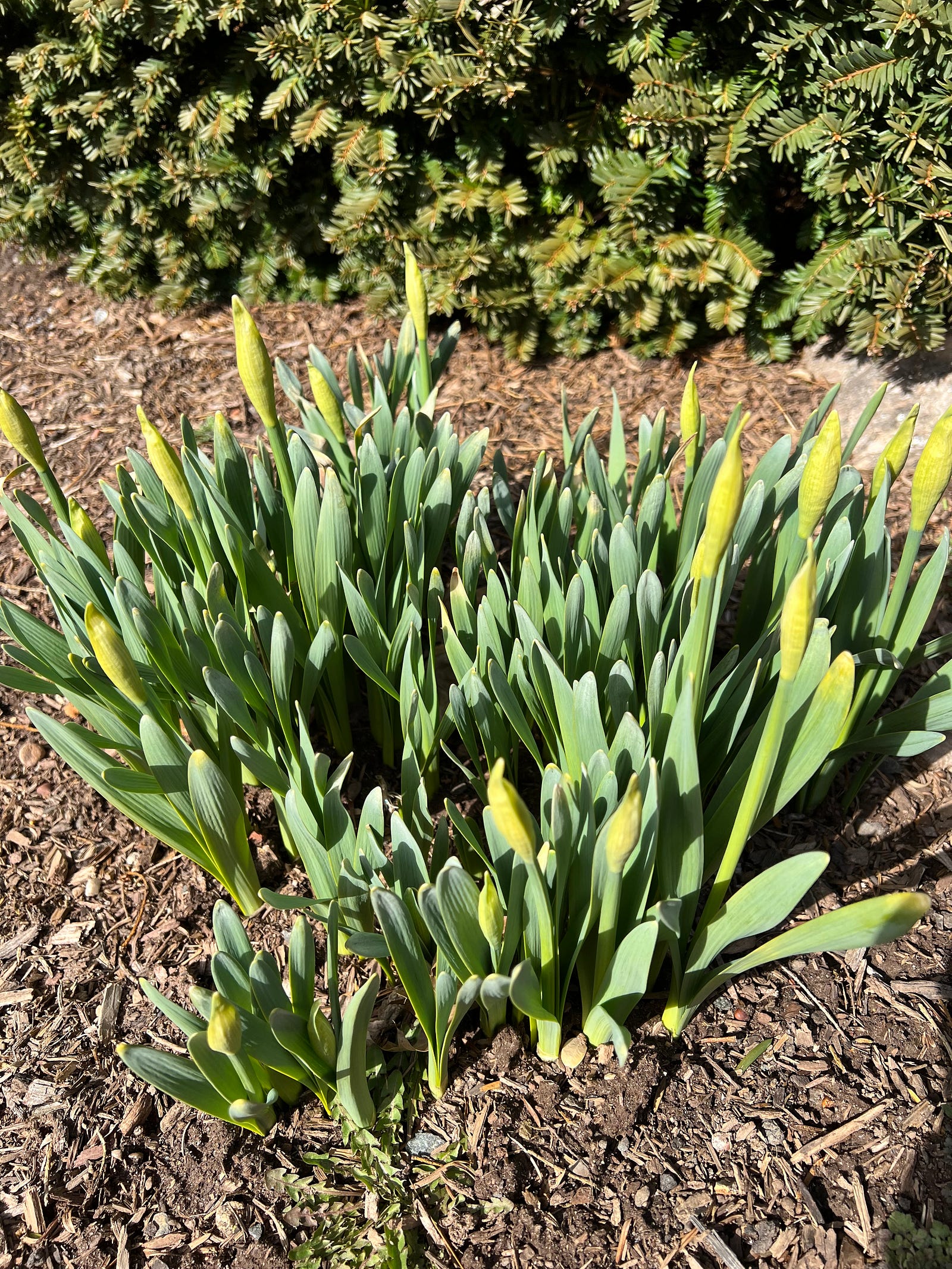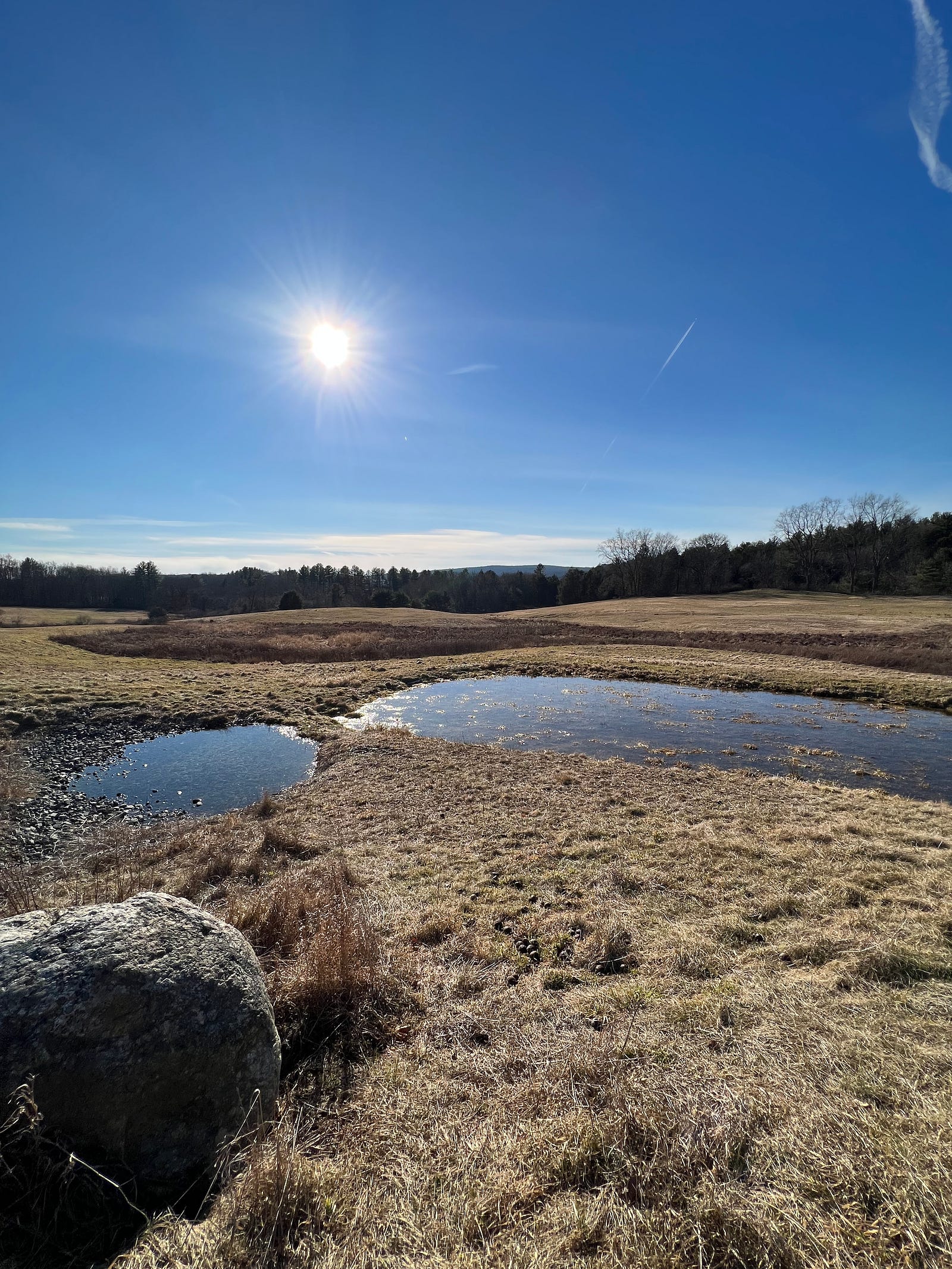Sermon: Once you SEE it, You Can’t Unsee It…
Published by Ronald Steed,
CONFLICT | SUFFERING | DEATH | NEW LIFE
Sermon: Once you SEE it, You Can’t Unsee It…
St Andrews Episcopal Church Madison, CT ¹, John 11:1–45 ²

There is an underlying pattern to the Gospel | Photo by Ron Steed
There’s A Different Pattern
Many Christians believe that the the whole idea of Christianity is to escape an evil Earth when you die, then go to heaven and live forever as some disembodied spiritual being. In this version of Christianity, being eternally punished in hell is a real possibility.
That’s not the pattern we‘re hearing this morning. NONE of that is the Christian message the New Testament writers are telling. It is certainly NOT what John is telling us in the story of Lazurus.
John is telling us an Easter Story that is at the very heart of the Gospel, and it is GOOD NEWS; it is the Cliff Notes version of the same story we hear throughout the healing stories in the gospels, in many of the parables, and that we are going to hear very soon in Holy Week.
All of these are part of the SAME Easter pattern that includes the following elements:
- conflict,
- suffering,
- death in some form (literal or figurative),
- mourning and loss (which is where the hell is BTW),
- and THEN… the creator God brings new creation and new life.
And THAT is the Christian message and the Christian hope. THAT is the pattern of the Gospel.

The pattern begins with conflict | Photo by Ron Steed
The pattern begins with conflict within an incredibly diverse creation, and ends with new creation. Hell is somewhere in the middle and it’s not permanent… rather, in some profound way, the suffering and mourning and loss, like the weeping of Jesus, Mary and Martha, and their neighbors, somehow rolls away the stone from the tomb where new creation emerges.
Conflict is a Feature, not a Bug
Lazarus’ story begins with two conflicts. The FIRST is that Lazarus becomes sick and the conflict is between his life and the life of something that infects him. Both lives, Lazarus and the infection are lives created by God. Here we have the diversity of creation, God’s creation… human life and viral life, come into conflict.
Here’s the shocker; conflict is not a BUG in God’s creation software; it’s a feature. It is no accident that the highlight of the eucharistic prayer is when Shariya breaks the host in two. And it’s not only the Body of Christ in the bread that gets broken; it’s also the Body of Christ sitting in the pews. Just let that sink in.

The highlight of the Eucharist is that something gets broken | Photo by Ron Steed
The SECOND conflict in the story, is the increasingly intense conflict Jesus has with Judaean leaders and ultimately with the Romans, that is headed toward a climax very soon during what we call Holy Week. "Rabbi, the Jews were just now trying to stone you, and are you going there again?" "Yes, yes I am" says Jesus, who does not run from the conflict or fight against it… rather, he rolls with it.
Jesus’ response to conflict, OUR response to conflict, seems to be part of the pattern God wants us to see.
Here I need to be crystal clear. I don’t want to pretend for a second that to Mary and Martha, and even to Jesus as he wept, Lazarus’ death seemed wrong, and senseless, and awful… they might have even called it evil. For anyone who has lost loved ones, illness, accident, and injustice is horrible… we feel that deeply, we grieve these losses.

We grieve loss and feel it deeply. And yet, there is transformation also | Photo by Ron Steed
And yet… somehow, there is a mystery at the center of the Gospel; that conflict gets used for transformation. That a part of the good news is that weeping turns to joy. And if weeping hasn’t turned to joy yet, then the story is not yet over. Weeping does not have the last word.
Conflict: the Engine of Creativity
Conflict is in the center… conflict that can lead to illness, alcoholism, old age, homelessness, and death; all the human tragedies and traumas that bring, even Jesus, to tears alongside us. To the world, death is the end of the story, but to Christians, death is NOT the end of the story… why?
Because going to heaven is not the point; heaven comes to us… the endlessly creative God comes to LIVE with us and in us. And he comes to us in the form of the one who says "I am the resurrection and the life."
The creator is ENDLESSLY creative and always moving. God didn’t FINISH creating on the 7th day, God just took a sabbath rest… God is STILL creating… and the conflict wired into the fabric of creation becomes the ENGINE for creativity, for Jesus, for us humans, and for the creator.

Conflict is the engine of creativity | Photo by Ron Steed
The Gospels are FULL of this story pattern, where weeping turns to joy:
- Jesus healing the sick is one way the Gospel writers tell the Easter story,
- the restoration of the prodigal son in Luke is the same story,
- so is the rescue of the beaten-one-in-the-ditch by the Good Samaritan.
- The raising of Lazarus from the dead in John repeats the pattern,
- and soon, the resurrection of Jesus will be told.
These are all the SAME Gospel story.
We are C0-Creators
AND, we humans are called to be CO-creators with GOD. Jesus orders the Lazarus’ community to finish the transformation: "unbind him and let him go". This is a call to JUSTICE, not just a charitable removal of bandages, but setting FREE our formerly dead neighbor to live their new life. This co-creation, this justice-work, is part of the Gospel too; it’s called reconciliation, the restoration of relationships.
The Recurring Pattern of Good News
Conflict with Alcohol
I knew a man who suffered his whole life with alcohol, and that is not an unusual form of living-death for a lot of you in your own families. One day late in life, as he lay jaundiced in a hospital bed, a Doctor visited.
"As I look at you in this bed", the Doctor said to the man, "I see myself a few years ago. You have a choice to make today. You can keep doing what you are doing, and suffer a long and agonizing hell as your liver fails, OR, you can ask me to take you to Alcoholics Anonymous, an even harder cross-shaped path, where you might have a chance to have a new life."

Alcohol addiction is a tangled and living hell on Earth | Photo by Ron Steed
This doctor was like Jesus calling for Lazarus to come out of the tomb.
The man came out of that tomb and went to AA. There, the AA community did some justice; they unbound him and let him go. Those 12 steps were hard and painful… a cross the man had to carry, and he did.
Over time, the man became a Sponsor himself, and like that Doctor, acted as Christ in the world for others suffering from alcoholism. New life; new creation. Lazarus raised from the dead and reconciled with his community.
Conflict with Old Age
I have known people suffering from old age who discovered a new vocation of service near the end of their lives; strengthening broken relationships, inspiring their families and neighbors with vision and with hope, coming to a place of deep spiritual wisdom and kindness that they were eager to share… arriving at a place of profound healing, not in their aging bodies, but certainly in their lives.
These were venerable and wise people, raised to new life near the end of this life with new purpose… and then, fully ready to enter into a time of sabbath rest when the time came, as it will, for all of us.

A sabbath rest? | Photo by Ron Steed
Maybe we will take a sabbath rest like the creator God took on the 7th day. The New Testament writers tell us that, because the creator God is endlessly creative, we will get resurrected just as Christ was resurrected, in a new, more human body, here on Earth. Maybe we have a pit stop in heaven, the writers don’t say and we don’t really know. But the whole point of the New Testament Writers is that heaven is coming to Earth, and we, and our friends and neighbors are coming with it into new life!
Conflict with Homelessness
I have seen people suffering homelessness who are in living hell… they are DEAD as neighbors, dead as citizens… they enter the tomb of a homeless shelter, where they are brought back to life by volunteers and staff who, like Jesus, call to them.
They are rehoused and restored as neighbors… they are restored to dignity. Lazarus raised from the dead and reconciled with their community.
In July, we are taking a large group of young adults and parents on a Project HOME journey to Maine, where I hope THEY will see the same pattern among guests there who suffer from homelessness. I wish I had understood the good news at 14 that I now know at 63. If I had, I might have lived my life very differently. But that’s ok too! Part of the Gospel pattern is that nothing is wasted, even if you don’t see the gospel pattern until late in life!
If You SEE the Pattern…
If you know what the pattern looks like, you will SEE Lazarus raised from the dead every day in this parish, in your families, out there in the world… THAT is the Christian Hope. And it is a hope we can see in the present moment all around us, in THIS life.

This pattern, IS the Christian Hope | Photo by Ron Steed
It’s one of the reasons as a Deacon, I keep pushing you toward Justice work… so that you will get transformed when you see the Gospel pattern at work! When you feel your weeping turned to joy by the hands of someone you think you’re there to help!
The focus and energy of Christian life is NOT life after death… that’s NOT what New Testament writers like John are telling us. Their stories, like John’s story today, are about new life and new creation in THIS life… here… among us, old and young together… out there in Madison, Guilford, and New Haven… in thin-places where heaven and earth come together, intersect and overlap.
Where a doctor stands at a bedside of a suffering alcoholic, in a chair as a neighbor calls a aging one to new purpose, in the tomb of a shelter where the team houses a couple who had been living in their car, at a table where a 16 year old shares a meal with another experiencing homelessness and receives the gospel as a gift from them. THESE are the thin-places of new creation and new life.
We see this pattern in the story of Lazarus, and we will witness the SAME pattern, even more profoundly during Holy Week. And once you SEE the pattern, you can’t UNSEE it.
During our lives, we are given the Holy Spirit that literally lives within us… the presence of the creator God within us. The endlessly creative God who is always on the move, is showing us this Gospel pattern, this Easter pattern, over and over again. God is showing us what HAS happened, what IS happening NOW, and what WILL happen in the future. If you see the gospel pattern, you can’t unsee it.
The question is… what will you DO with it, once you see it?

Once you see the pattern, what will you DO with it? | Photo by Ron Steed
¹ This sermon was delivered at St. Andrews Episcopal Church, Madison, CT, on Sunday, March 26, 2023, Fifth Sunday in Lent (Year A)
² John 11:1–45 (NRSV): Now a certain man was ill, Lazarus of Bethany, the village of Mary and her sister Martha. Mary was the one who anointed the Lord with perfume and wiped his feet with her hair; her brother Lazarus was ill. So the sisters sent a message to Jesus, "Lord, he whom you love is ill." But when Jesus heard it, he said, "This illness does not lead to death; rather it is for God’s glory, so that the Son of God may be glorified through it."
Accordingly, though Jesus loved Martha and her sister and Lazarus, after having heard that Lazarus was ill, he stayed two days longer in the place where he was.
Then after this he said to the disciples, "Let us go to Judea again." The disciples said to him, "Rabbi, the Jews were just now trying to stone you, and are you going there again?" Jesus answered, "Are there not twelve hours of daylight? Those who walk during the day do not stumble, because they see the light of this world. But those who walk at night stumble, because the light is not in them."
After saying this, he told them, "Our friend Lazarus has fallen asleep, but I am going there to awaken him." The disciples said to him, "Lord, if he has fallen asleep, he will be all right." Jesus, however, had been speaking about his death, but they thought that he was referring merely to sleep. Then Jesus told them plainly, "Lazarus is dead. For your sake I am glad I was not there, so that you may believe. But let us go to him." Thomas, who was called the Twin, said to his fellow disciples, "Let us also go, that we may die with him."
When Jesus arrived, he found that Lazarus had already been in the tomb four days. Now Bethany was near Jerusalem, some two miles away, and many of the Jews had come to Martha and Mary to console them about their brother.
When Martha heard that Jesus was coming, she went and met him, while Mary stayed at home. Martha said to Jesus, "Lord, if you had been here, my brother would not have died. But even now I know that God will give you whatever you ask of him." Jesus said to her, "Your brother will rise again." Martha said to him, "I know that he will rise again in the resurrection on the last day."
Jesus said to her, "I am the resurrection and the life. Those who believe in me, even though they die, will live, and everyone who lives and believes in me will never die. Do you believe this?" She said to him, "Yes, Lord, I believe that you are the Messiah, the Son of God, the one coming into the world."
When she had said this, she went back and called her sister Mary, and told her privately, "The Teacher is here and is calling for you." And when she heard it, she got up quickly and went to him.
Now Jesus had not yet come to the village, but was still at the place where Martha had met him. The Jews who were with her in the house, consoling her, saw Mary get up quickly and go out. They followed her because they thought that she was going to the tomb to weep there.
When Mary came where Jesus was and saw him, she knelt at his feet and said to him, "Lord, if you had been here, my brother would not have died." When Jesus saw her weeping, and the Jews who came with her also weeping, he was greatly disturbed in spirit and deeply moved. He said, "Where have you laid him?" They said to him, "Lord, come and see."
Jesus began to weep. So the Jews said, "See how he loved him!" But some of them said, "Could not he who opened the eyes of the blind man have kept this man from dying?"
Then Jesus, again greatly disturbed, came to the tomb. It was a cave, and a stone was lying against it. Jesus said, "Take away the stone." Martha, the sister of the dead man, said to him, "Lord, already there is a stench because he has been dead four days." Jesus said to her, "Did I not tell you that if you believed, you would see the glory of God?"
So they took away the stone. And Jesus looked upward and said, "Father, I thank you for having heard me. I knew that you always hear me, but I have said this for the sake of the crowd standing here, so that they may believe that you sent me."
When he had said this, he cried with a loud voice, "Lazarus, come out!" The dead man came out, his hands and feet bound with strips of cloth, and his face wrapped in a cloth. Jesus said to them, "Unbind him, and let him go." Many of the Jews therefore, who had come with Mary and had seen what Jesus did, believed in him.